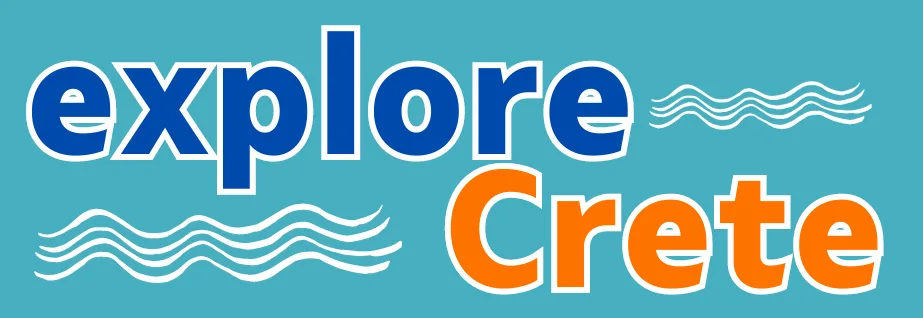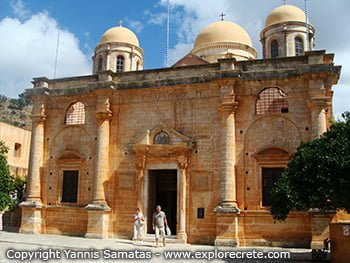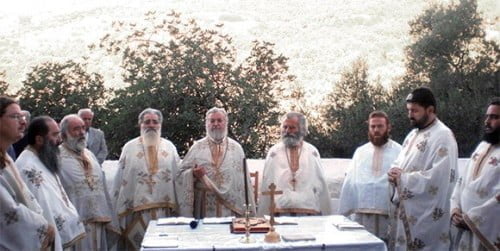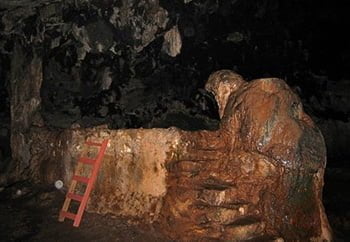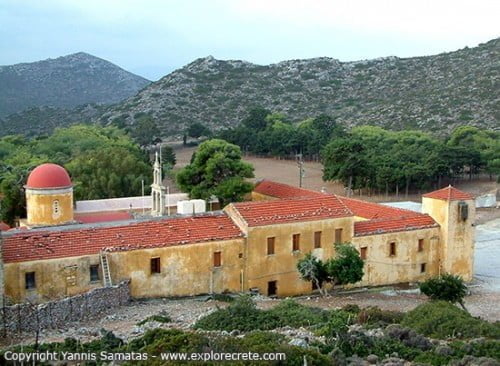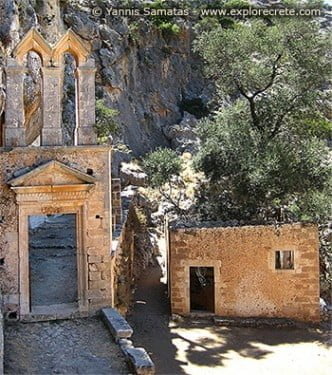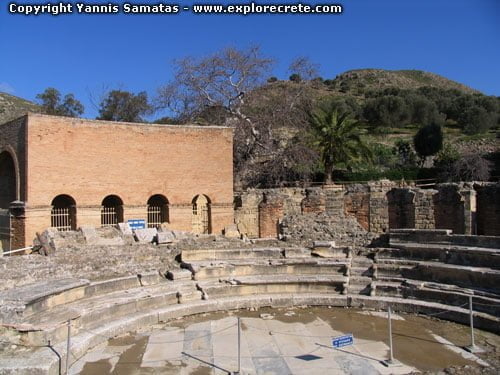Pictures of Koudoumas Monastery
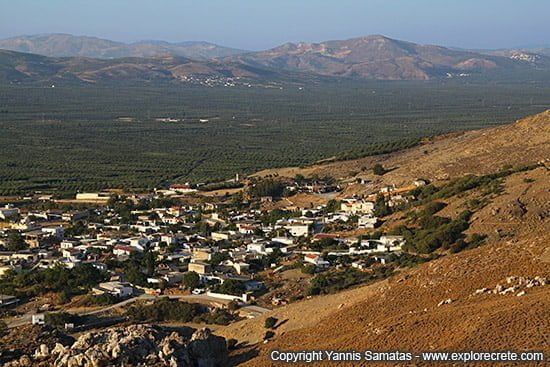
Sternes is the last village before Koudoumas Monastery. From here on the road climbs towards the peak of Kofinas. Note the difference between the green Messara plain and the arid slopes of Kofinas after Sternes. 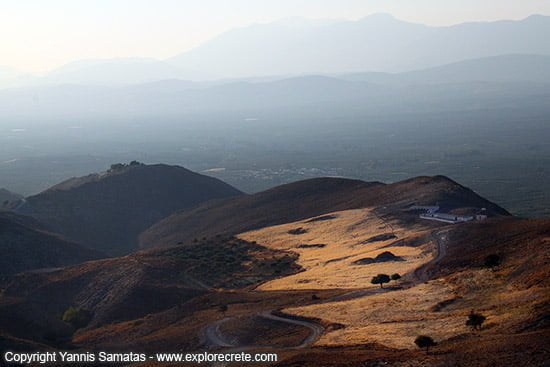
Typical landscape in the Asterousia Mountains in summer, with the dry grasses shining on the hillsides. 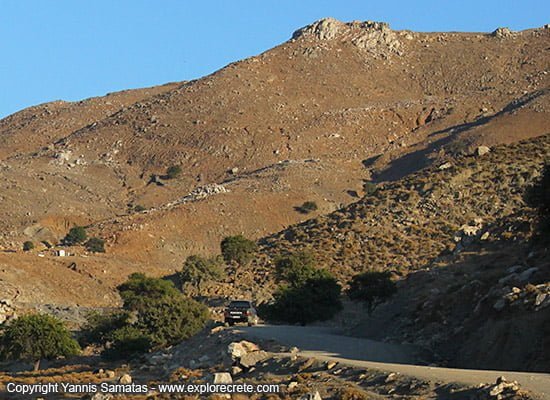
The road to Koudoumas Monastery is a dirt road accessible to any vehicle with normal ground clearance. Be careful on the blind bends because a car coming in the opposite direction may suddenly appear in front of you. 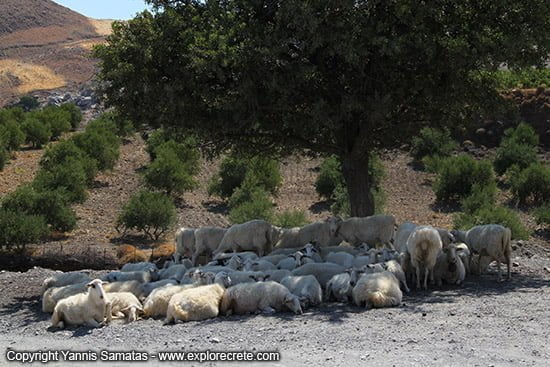
Sheep enjoying the shade of a tree. In the Asterousia Mountains trees are few and the summer sun beats down on people and animals alike. 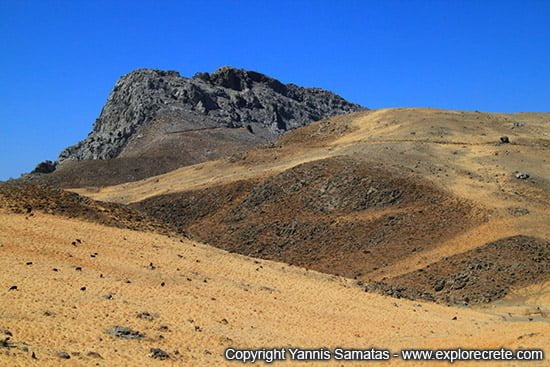
Ο Kofinas is 1,231 metres high. Going to Koudoumas Monastery you will reach quite a high altitude, about 800 to 900 metres, and the peak will be on your right. 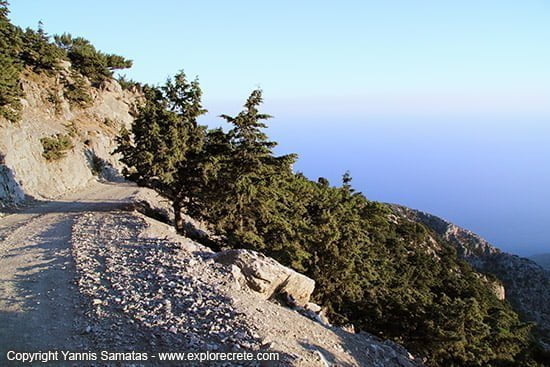
As you start the descent to Koudoumas Monastery, the road is still an accessible dirt track, but the route is more pleasant because you are moving through the pine and cypress wood on the south slope of Kofinas, with a view of the deep blue Libyan Sea. 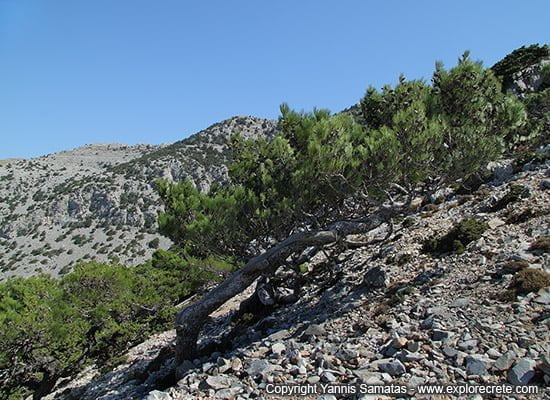
This pine tree has grown parallel to the ground, as if trying to lie down. This is due to the strong north wind that often blows in the area. Trees are forced to adapt by leaning at the angle offering least resistance to the wind. 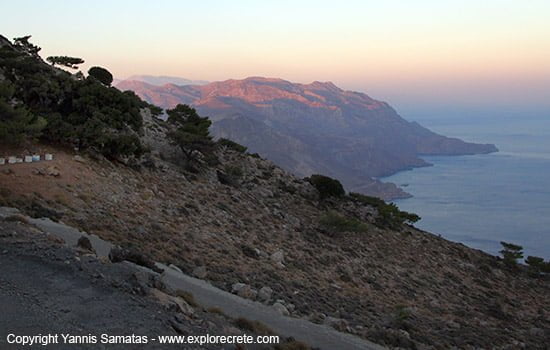
The view to the east and the seaside village of Tris Ekklisies. There is no road from Tris Ekklisies to Koudoumas Monastery, only the old path from Koudoumas to Agios Pavlos and Paranymphi village, several hours’ walk. 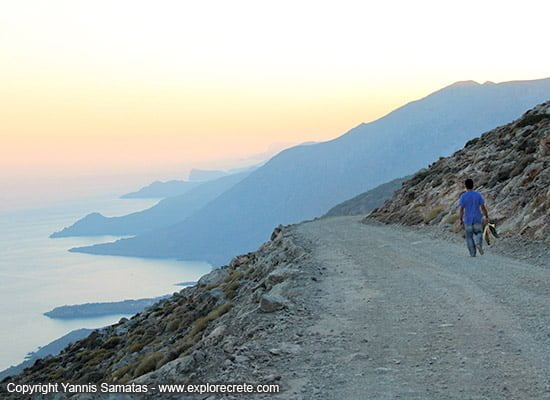
The view in the opposite direction, west to Lendas and Kali Limenes. The solitary walker is fulfilling his vow to the Virgin of Koudoumas to walk to the monastery on her feast-day. On the eve of the festival many pilgrims walk the 24 kilometres from Sternes to Koudoumas. 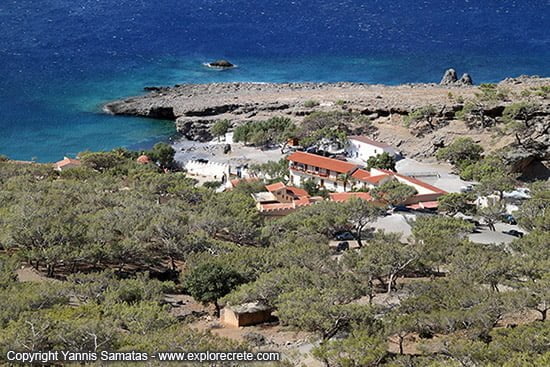
Koudoumas Monastery seen from above. We are now quite close, less that 15-20 minutes away. The 24 kilometres of dirt road from Sternes are 1-1.5 hours’ drive. 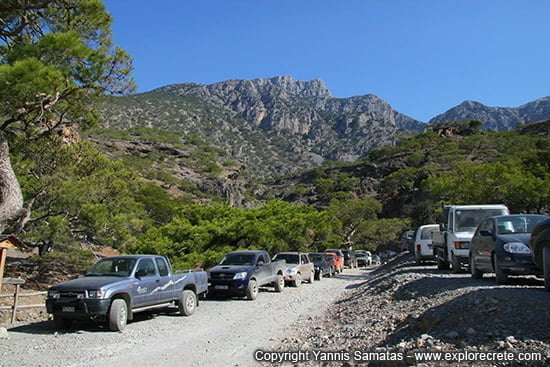
On the eve of the Dormition of the Virgin (15 August), many people come to Koudoumas Monastery to celebrate with the monks, as we can see from the dozens of cars outside the monastery. 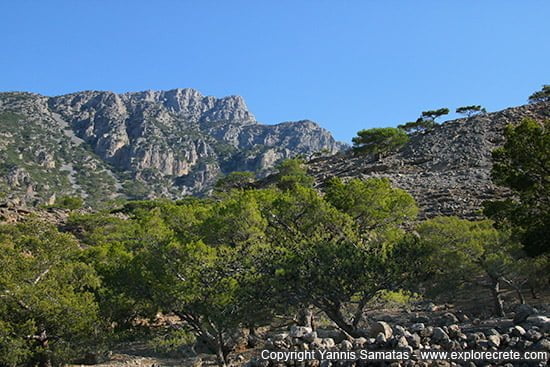
Koudoumas Monastery is set in a pinewood, with Mount Kofinas looming above. 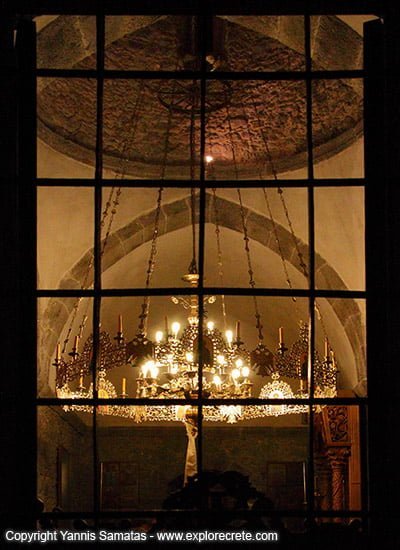
On the eve of the Dormition at Koudoumas the service begins early in the afternoon and lasts into the night. 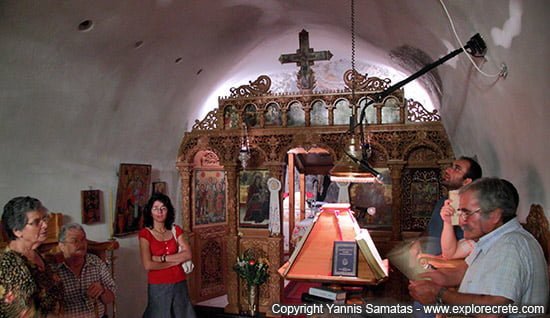
Late at night, the service is nearly over and only a few people remain in the little church. 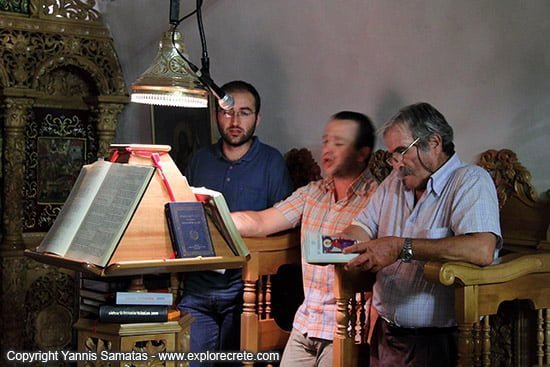
The cantors are neither permanent nor professionals, simply churchgoers who like Byzantine music and have a good voice. 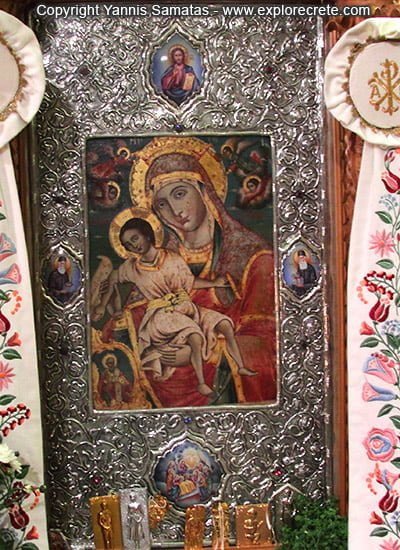
The icon of the Virgin of Kykkos, acquired by Koudoumas Monastery in 1957, is considered miraculous, as you can see from the many votive offerings hanging from it. 
Closeup of the Virgin of Kykkos or Virgin Dexiokratoussa. It was probably painted in the Kykkos Monastery in Cyprus. History reports that it was discovered in the house of Ali Pasha in Ioannina by an Italian archaeologist. 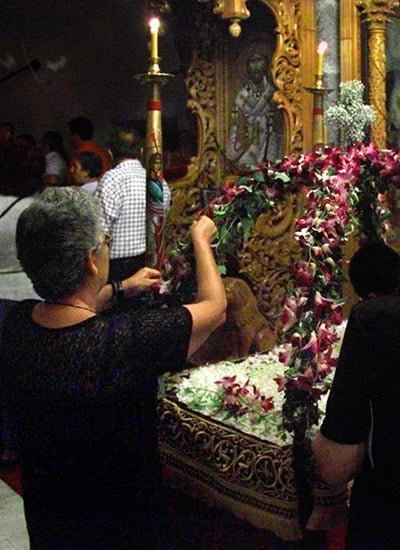
It is an unusual custom, but at Koudoumas Monastery they make a bier (epitaphios) in honour of the Dormition of the Virgin. Here a woman fixes the flowers on the bier. 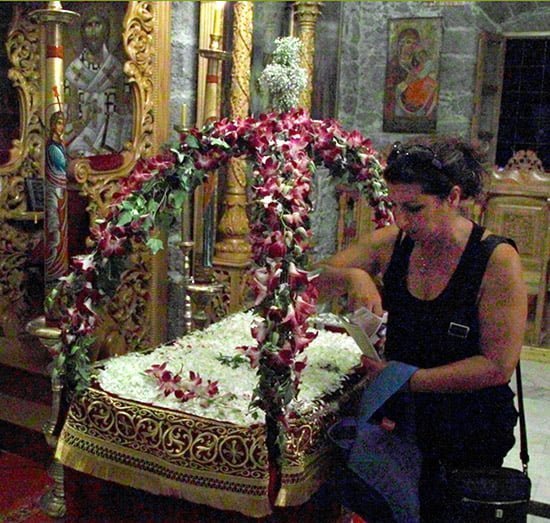
Both with the Epitaphios of Christ at Easter and with that of the Virgin, it is a common custom for people to pass under the bier for a blessing. Here we see a woman taking a few petals from the epitaphios flowers. She will take them home to avert evil from her family. 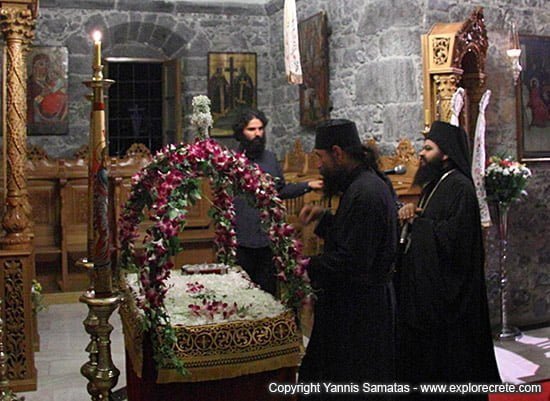
The Abbot of Koudoumas Monastery with two monks in front of the bier of the Virgin. 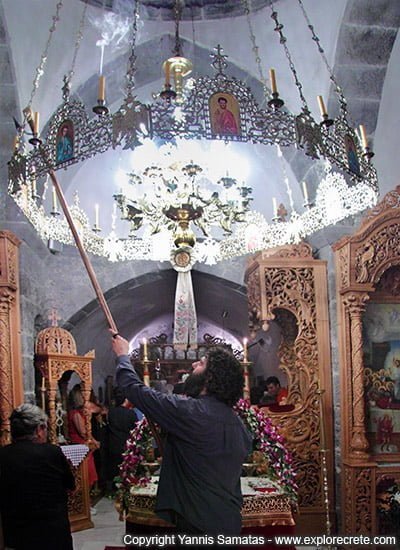
The service is over and the novice monk snuffs out the candles in the great chandelier. 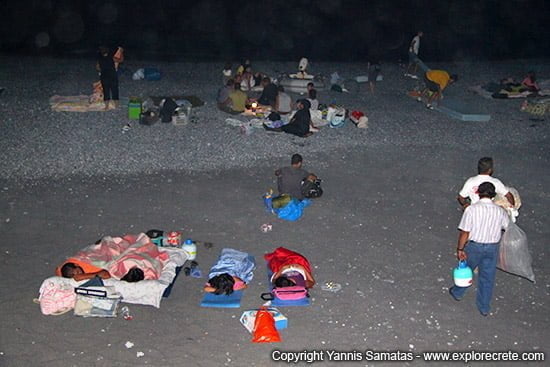
On the eve of the Dormition many people who have come to Koudoumas Monastery to worship will spend the night on the beach. 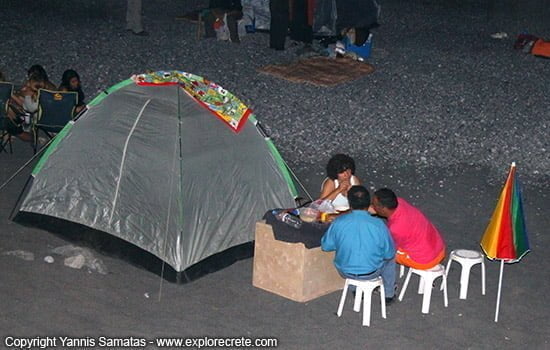
Some better-organised people have come with their tent and chairs. 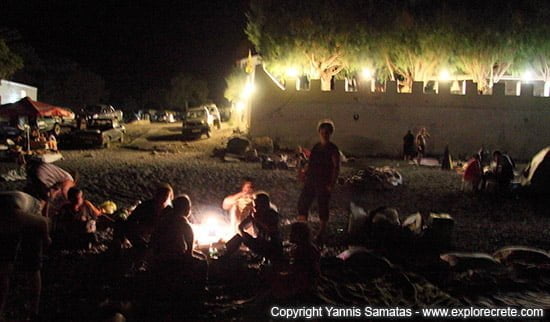
A group of people who will spend the night on the beach, against the lights of the monastery. 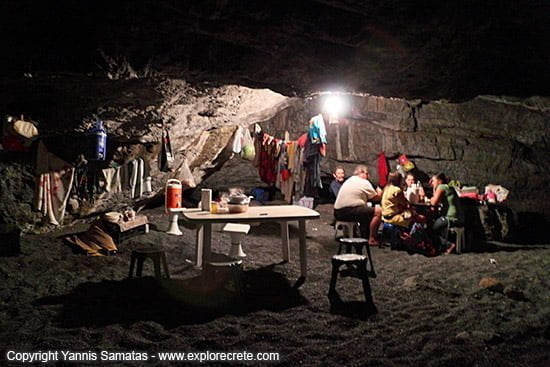
This cave on Koudoumas beach looks like a manger scene. 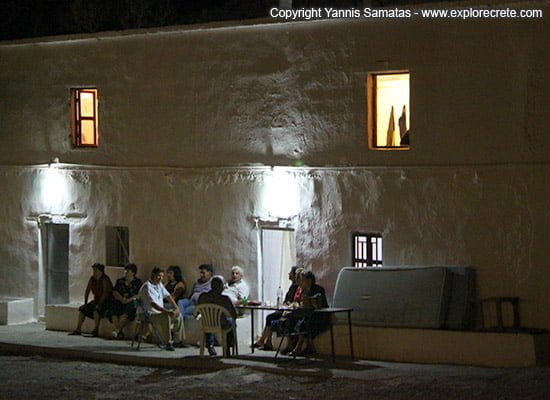
Most people don’t spend the night on the beach but stay in the guestrooms of Koudoumas Monastery, which, however, are not enough for everybody. 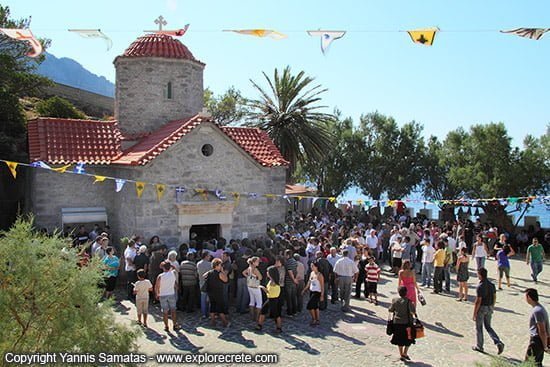
15 August, the great festival of the Virgin at Koudoumas Monastery, and people are gathered around the monastery church. 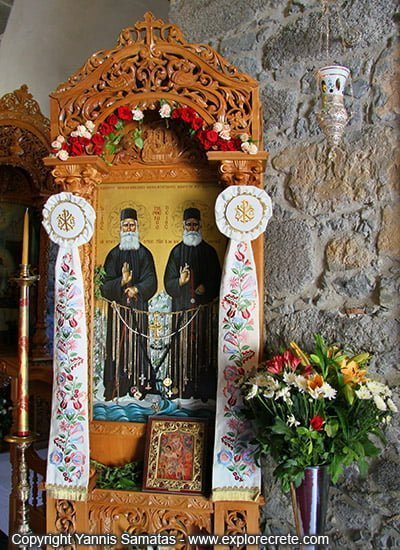
Koudoumas Monastery was built by the brothers Eumenios and Parthenios, who were monks and hermits. When they came here, there were only the ruins of the church of an older 14th-century monastery. Parthenios saw a vision of the Virgin who asked him to build a monastery in her name here. Construction began in 1878 and was completed in 1895. 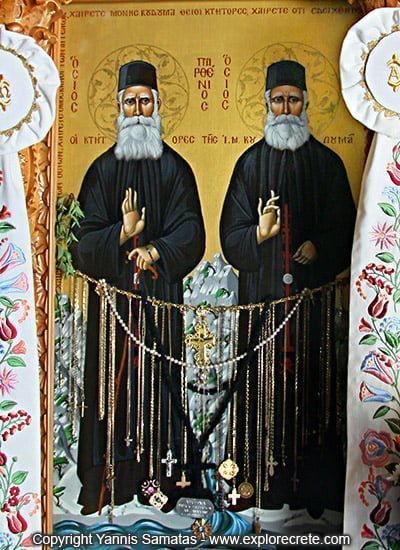
Closeup of Ss Parthenios and Eumenios. Their feast-day is on 10 July and their relics are housed in Koudoumas Monastery. 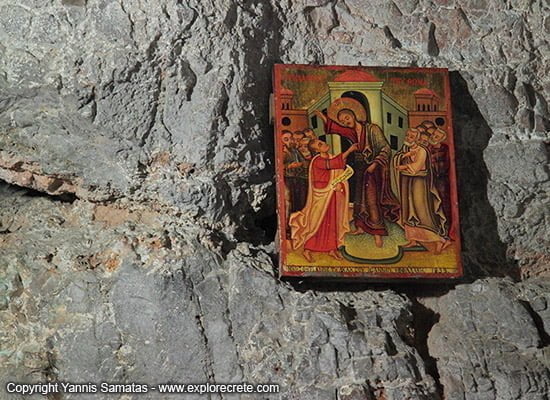
The sanctuary of the monastery church is in a cave, on the site of the ruined 14th-century monastery. Here we see the cave walls and an old icon dated 1899. 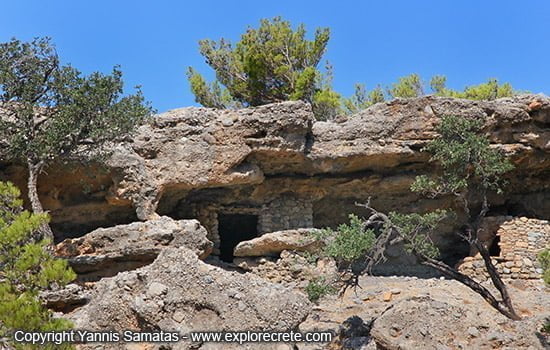
In these caves, converted into monks’ cells, lived those who built Koudoumas Monastery from 1878 to 1895. 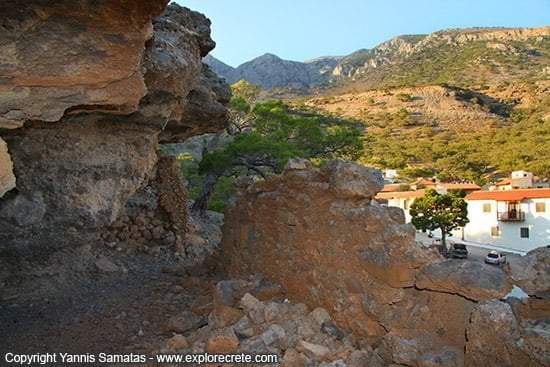
One of the cave-cells opposite Koudoumas Monastery. Only a few ruins remain of the built outer wall, which provided protection from the wind, rain and cold to those who lived here while the monastery was being built. 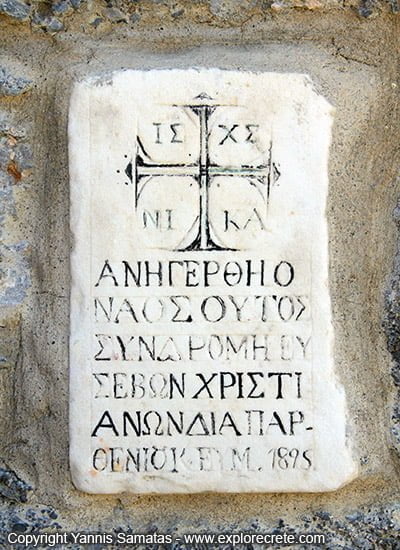
This plaque was set into the wall of the church when Koudoumas Monastery was opened in 1895. 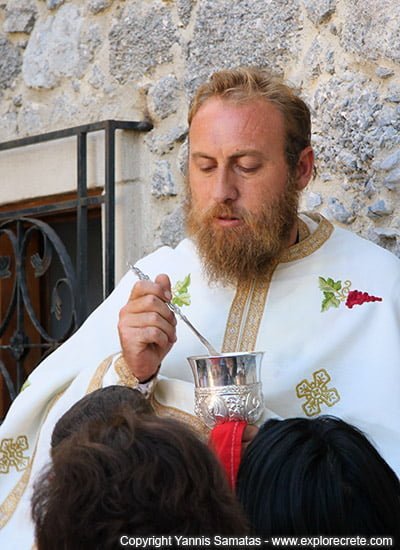
After the service, those who have fasted for the Dormition can take Communion. 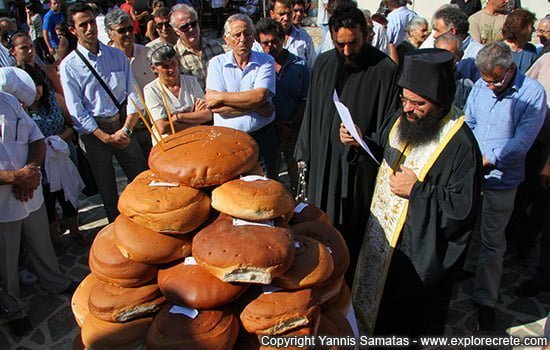
Every family can offer 5 loaves to the church (artoplasia). One loaf from each family, the family name written on a piece of paper, is collected by the priest together with the others and blessed. The family who brought it then takes this loaf home, while the other four are distributed to the faithful. 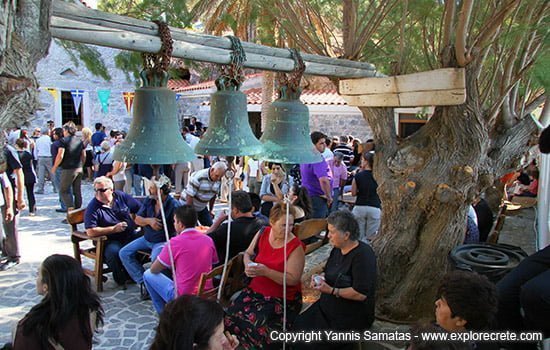
The service is over and people enjoy the shade of the pines in the monastery courtyard. 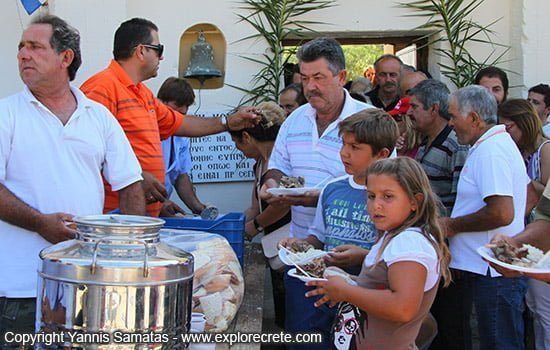
After the service, the monastery provides a free meal for those present. It consists of boiled goat and pilaf in broth, a traditional Cretan dish eaten at weddings and christenings. 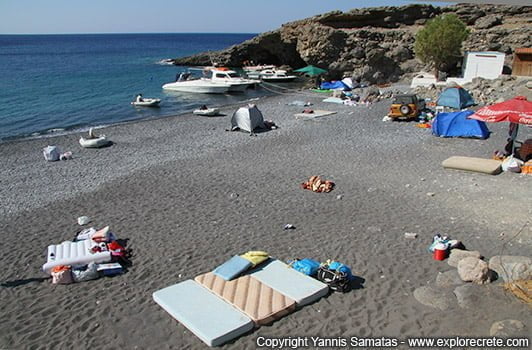
The beach directly in front of Koudoumas Monastery on the morning of 15 August. The mattresses and tents are still here from the night before. 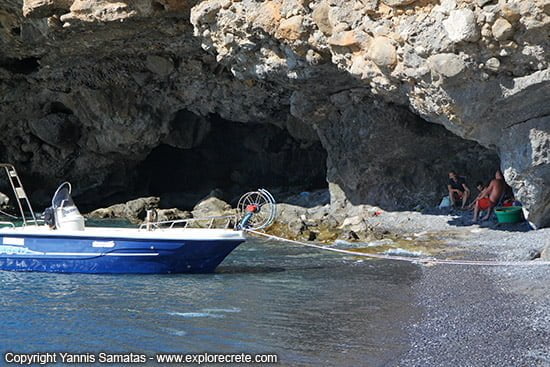
Koudoumas beach offers everything, even mooring and a cave for fishermen and their equipment. 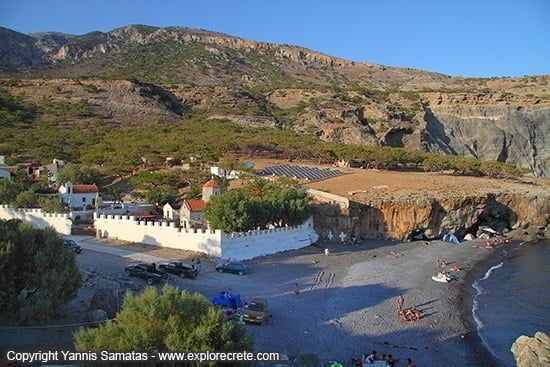
On the afternoon of the Dormition many people have already left, as you can see from this picture of the beach. 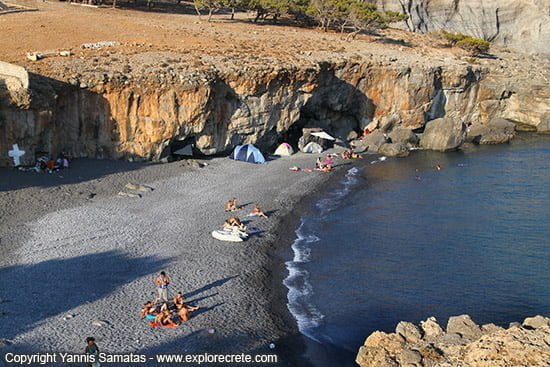
Koudoumas Monastery with a few tents on the east side. 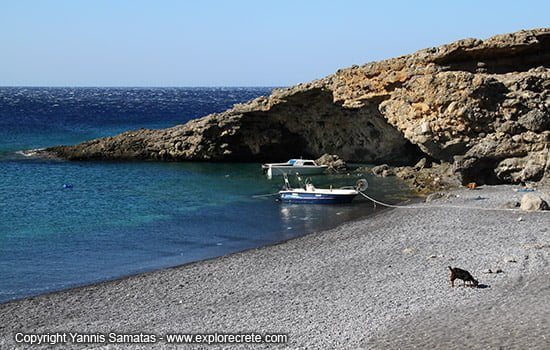
The day after the feast of the Dormition the beach is almost empty. Most people have gone home, encouraged by the strong north wind that suddenly began to blow. 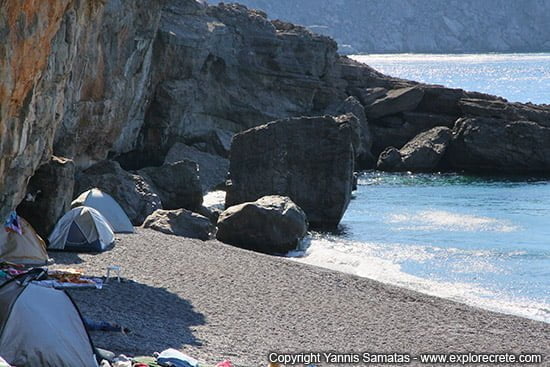
Usually people pitch their tents at the east end of the beach, where there are caves to provide shade and shelter from the wind. 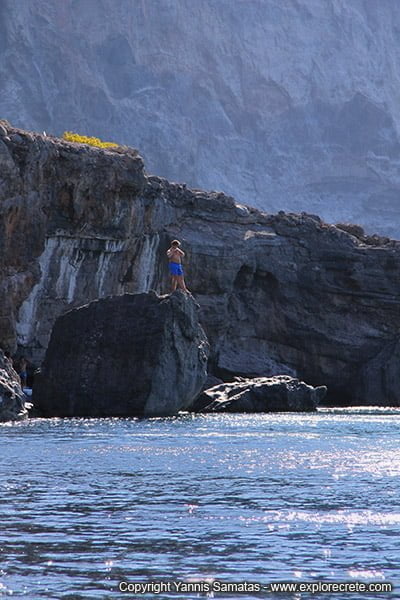
The young man on the rocks seems about to plunge into the crystal-clear waters of south Crete. 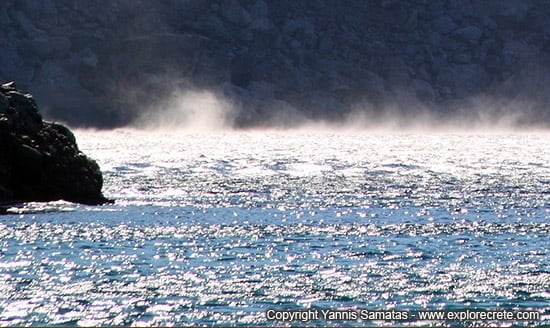
The wind blows so hard that just off Koudoumas it whips up the sea into small waterspouts. 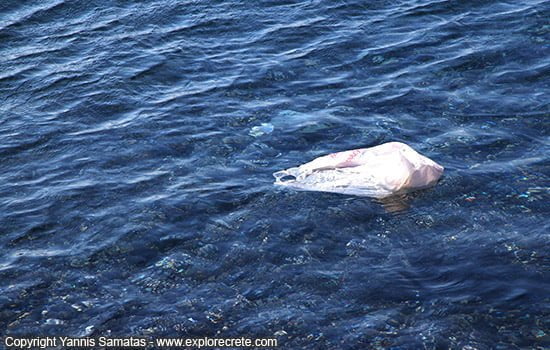
The wind and human negligence are a bad combination for the sea. Here we see a plastic bag that someone let go of for a moment and the strong north wind blew it into the sea. Plastic bags are dangerous to sea creatures such as seals and turtles, which can mistake them for jellyfish and swallow them. 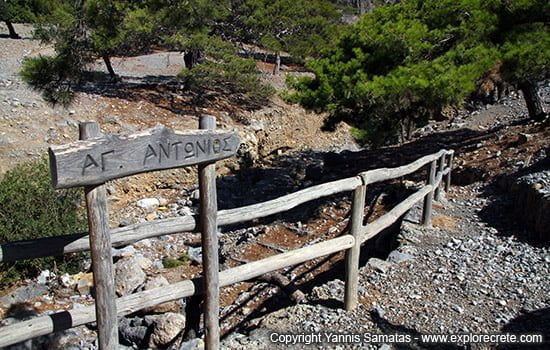
From this point at the entrance to Koudoumas Monastery starts the path to St Anthony’s Cave, 1.5 hours’ walk to the west. 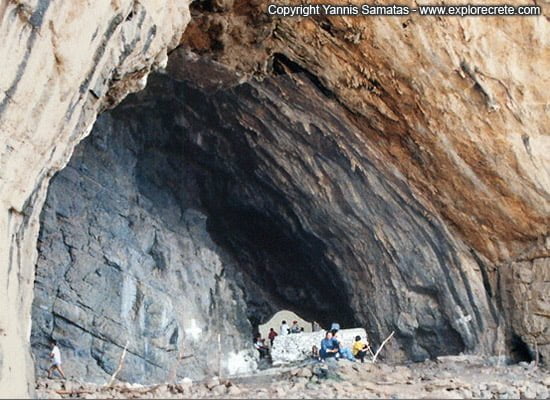
St Anthony’s Cave with the church of the same name built inside it. Many hermits lived in this cave, including the monks Parthenios and Eumenios. Inside the cave are 3 basins which fill with water dripping from the stalactites, considered holy water. 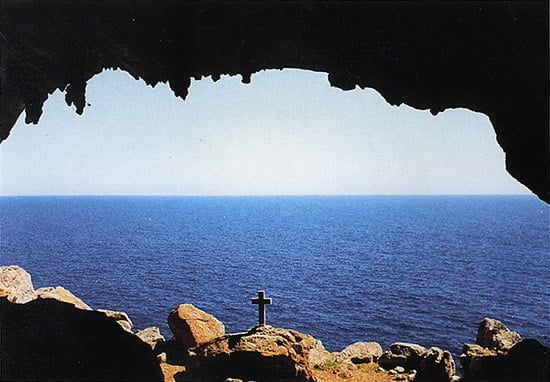
The Avvakospilio or Varvakospilio is another cave you can visit from Koudoumas Monastery, about 30 minute’s walk away. 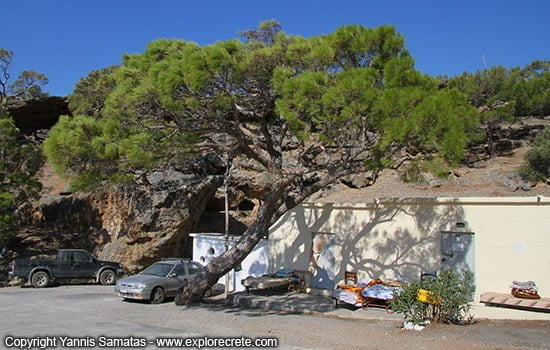
A little below this guesthouse opposite Koudoumas Monastery starts the path to the Avvakospilio. Here ends the photo album dedicated to Koudoumas Monastery. There is much more to discover and photograph in this remote corner of Crete, which manages to preserve the beauty nature has so generously endowed it with.
- Read more about the Monastery of Koudoumas
© explorecrete.com All Rights Reserved. Reproduction or copying without permission is prohibited.
